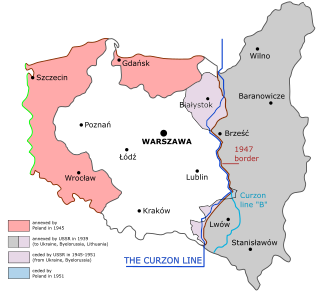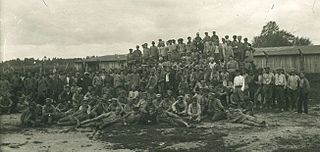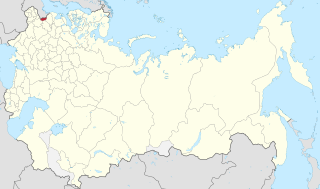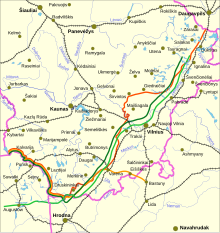
The Curzon Line was a proposed demarcation line between the Second Polish Republic and the Soviet Union, two new states emerging after World War I. Based on a suggestion by Herbert James Paton, it was first proposed in 1919 by Lord Curzon, the British Foreign Secretary, to the Supreme War Council as a diplomatic basis for a future border agreement.

The Polish–Soviet War was fought primarily between the Second Polish Republic and the Russian Soviet Federative Socialist Republic, following World War I and the Russian Revolution.

The Republic of Central Lithuania, commonly known as the Central Lithuania, and the Middle Lithuania, was an unrecognized short-lived puppet state of Poland, that existed from 1920 to 1922. It was founded on 12 October 1920, after the successful Żeligowski Mutiny, during which the volunteer 1st Lithuanian–Belarusian Division under the command of general Lucjan Żeligowski seized the Vilnius Region that Lithuania made claims to. It was incorporated into Poland on 18 April 1922.

Suwałki is a city in northeastern Poland with a population of 69,206 (2021). It is the capital of Suwałki County and one of the most important centers of commerce in the Podlaskie Voivodeship. Suwałki is the largest city and the capital of the historical Suwałki Region. Until 1999 it was the capital of Suwałki Voivodeship. Suwałki is located about 30 km (19 mi) from the southwestern Lithuanian border and gives its name to the Polish protected area known as Suwałki Landscape Park. The Czarna Hańcza river flows through the city.

Sejny is a town in north-eastern Poland and the capital of Sejny County, in Podlaskie Voivodeship, close to the northern border with Lithuania and Belarus. It is located in the eastern part of the Suwałki Lake Area, on the Marycha river, being a tributary of the Czarna Hańcza. As of 1999 it had almost 6,500 permanent inhabitants, with a strong seasonal increase during the tourist season.

The Polish–Lithuanian War was an undeclared war fought in the aftermath of World War I between newly independent Lithuania and Poland, with fighting mainly in the Vilnius and Suwałki regions, which was part of the Lithuanian Wars of Independence and lasted from May 1919 to 29 November 1920. Since the spring of 1920, the conflict happened alongside the wider Polish–Soviet War and was affected by its progress. It was subject to unsuccesful international mediation at the Conference of Ambassadors and the League of Nations.

Suwałki Region is a historical region around the city of Suwałki in northeastern Poland near the border with Lithuania. It encompasses the powiats of Augustów, Suwałki, and Sejny, and roughly corresponds to the southern part of the former Suwałki Governorate.

The Lithuanian Wars of Independence, also known as the Freedom Struggles, refer to three wars Lithuania fought defending its independence at the end of World War I: with Bolshevik forces, Bermontians, and Poland. The wars delayed international recognition of independent Lithuania and the formation of civil institutions.

The Soviet–Lithuanian Peace Treaty, also known as the Moscow Peace Treaty, was signed between Lithuania and Soviet Russia on July 12, 1920. In exchange for Lithuania's neutrality and permission to move its troops in the territory that was recognised during its war against Poland, Soviet Russia recognized the sovereignty of Lithuania. The treaty was a major milestone in Lithuania's struggle for international recognition and recognised Lithuania's eastern borders. Interwar Lithuania officially maintained that its de jure borders were those delineated by the treaty although a large territory, the Vilnius Region, was actually controlled by Poland.

The Sejny Uprising or Seinai Revolt refers to a Polish uprising against the Lithuanian authorities in August 1919 in the ethnically mixed area surrounding the town of Sejny. When German forces, which occupied the territory during World War I, retreated from the area in May 1919, they turned over administration to the Lithuanians. Trying to prevent an armed conflict between Poland and Lithuania, the Entente drew a demarcation line, known as the Foch Line. The line assigned much of the disputed Suwałki (Suvalkai) Region to Poland and required the Lithuanian Army to retreat. While the Lithuanians retreated from some areas, they refused to leave Sejny (Seinai), because of its major Lithuanian population. Polish irregular forces began the uprising on August 23, 1919, and soon received support from the regular Polish Army. After several military skirmishes, Polish forces secured Sejny and the Lithuanians retreated behind the Foch Line.

The general election in the Republic of Central Lithuania was an election to the Vilnius Sejm (parliament) of the Polish-dominated Republic of Central Lithuania on 8 January 1922. The new parliament was intended to formally legalize incorporation of Central Lithuania into Poland. Such measure was fiercely opposed by Lithuania, which claimed the territory for itself. The election was boycotted by non-Polish population and its results were unrecognized by either the Lithuanian government in Kaunas or the League of Nations. The elected parliament convened in February and, as expected, voted on 20 February 1922 to have the Republic incorporated into Poland. At the end of March 1922, Central Lithuania became Wilno Land of the Second Polish Republic.

Żeligowski's Mutiny was a Polish false flag operation led by General Lucjan Żeligowski in October 1920, which resulted in the creation of the Republic of Central Lithuania. Józef Piłsudski, the Chief of State of Poland, surreptitiously ordered Żeligowski to carry out the operation, and revealed the truth only several years afterwards.
The Suwałki Agreement, Treaty of Suvalkai, or Suwalki Treaty was an agreement signed in the town of Suwałki between Poland and Lithuania on October 7, 1920. It was registered in the League of Nations Treaty Series on January 19, 1922.

The 1938 Polish ultimatum to Lithuania was delivered to Lithuania by Poland on March 17, 1938. The Lithuanian government had steadfastly refused to have any diplomatic relations with Poland after 1920, protesting the annexation of the Vilnius Region by Poland. As pre-World War II tensions in Europe intensified, Poland perceived the need to secure its northern borders. On March 12, Poland, feeling supported by international recognition of the annexation of Austria by Nazi Germany, decided to deliver an ultimatum to Lithuania. The ultimatum demanded that the Lithuanian government unconditionally agree to establish diplomatic relations with Warsaw within 48 hours, and that the terms be finalized before March 31. The establishment of diplomatic relations would mean a de facto renunciation of Lithuanian claims to the region containing its historic capital, Vilnius.

The Lithuanian–Soviet War or Lithuanian–Bolshevik War was fought between newly independent Lithuania and the Russian Socialist Federative Soviet Republic in the aftermath of World War I. It was part of the larger Soviet westward offensive of 1918–1919. The offensive followed the retreat of German troops and sought to establish Soviet republics in Ukraine, Belarus, Lithuania, Latvia, Estonia, Poland and link up with the German Revolution. By the end of December 1918 Soviet forces reached Lithuanian borders. Largely unopposed, they occupied one town after another and by the end of January 1919 controlled about two thirds of the Lithuanian territory. In February, the Soviet advance was stopped by Lithuanian and German volunteers, who prevented the Soviets from capturing Kaunas, the temporary capital of Lithuania. From April 1919, the Lithuanian war went parallel with the Polish–Soviet War. Poland had territorial claims over Lithuania, especially the Vilnius Region; these tensions spilt over into the Polish–Lithuanian War.

Suwałki Governorate was an administrative-territorial unit (guberniya) of Congress Poland of the Russian Empire, which had its seat in the city of Suwałki. It covered a territory of about 12,300 square kilometres (4,700 sq mi).
The Polish coup d'état attempt in Lithuania refers to a failed attempt by Polish Chief of State Józef Piłsudski to overthrow the existing Lithuanian government of Prime Minister Mykolas Sleževičius, and install a pro-Polish cabinet that would agree to a union with Poland. The Polish intelligence agency, the Polish Military Organization (PMO), was to carry out the coup d'etat, planned to be implemented in August 1919. The coup was designed to seem to be an initiative by local Lithuanians aiming to free their government of German influence. The PMO hoped to rely on the assistance of sympathetic Lithuanian activists. They were thwarted by the lack of cooperation and the unwillingness of sufficient number of Lithuanians to support the Polish cause.

The Battle of Sejny, Battle of Suwałki or Sejny-Augustów operation took place during 2–23 September 1920, between the Polish and Lithuanian armies in the Suwałki Region. The fighting was especially focused on the towns of Sejny, Suwałki and Augustów.

The Lithuania–Poland border is the state border between the Republic of Lithuania and the Republic of Poland. The length of the border is 104 kilometres (65 mi). It runs from the Lithuania–Poland–Russia tripoint southeast to the Belarus–Lithuania–Poland tripoint. It is an internal border of the European Union and the Schengen Zone.

The Suwałki Gap, also known as the Suwałki corridor ( ), is a sparsely populated area around the border between Lithuania and Poland, and centres on the shortest path between Belarus and the Russian exclave of Kaliningrad Oblast on the Polish side of the border. Named after the Polish town of Suwałki, this choke point has become of great strategic and military importance since Poland and the Baltic states joined the North Atlantic Treaty Organization (NATO).


















